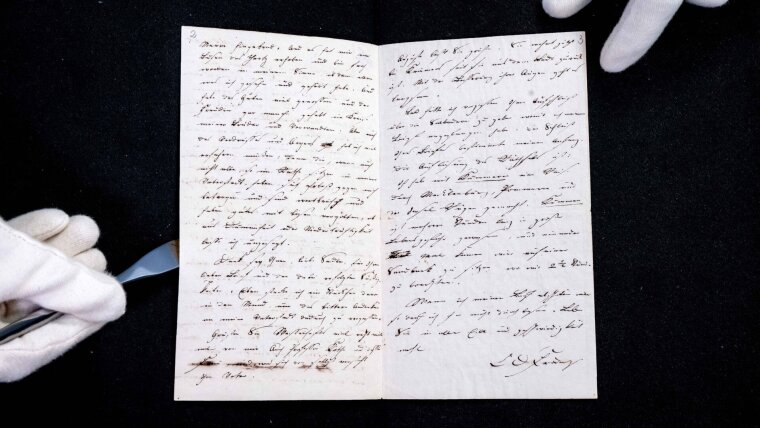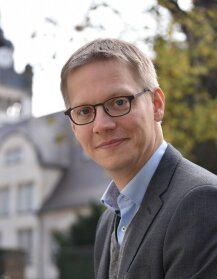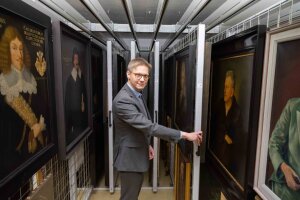
- Liberty
Published: | By: Sebastian Hollstein
Source article
The art historian Prof. Dr Johannes Grave is an expert on Caspar David Friedrich and a spokesperson for the proposed Cluster of Excellence "Imaginamics: Practices and Dynamics of Social Imagining".
Image: Jens Meyer (University of Jena)In the year of his 250th birthday on 5 September 2024, Caspar David Friedrich is more in demand than ever: exhibitions of his paintings are attracting record numbers of visitors. A large number of writings about Friedrich's life are conquering the book market and even the bestseller lists. The arts pages discuss new interpretations of his work and his person. Friedrich Schiller University Jena is an important centre of this anniversary event. On the one hand, current research in Jena is being channelled into various initiatives - on the other hand, the study of the artist is inspiring a planned Cluster of Excellence at the University of Jena.
The "European Romanticism Research Centre" at the University of Jena supported the major show at the Hamburger Kunsthalle at the beginning of the year as a scientific partner institution - the Jena Friedrich expert Prof. Dr Johannes Grave himself was one of two curators. The art historian also wrote catalogue contributions for the other major exhibitions in Berlin and Dresden in 2024. "It's very enriching to see how Caspar David Friedrich is viewed from very different perspectives and still finds an enthusiastic audience today," says Johannes Grave about his impressions during the anniversary year. "Even for me, new facets open up when you realise what answers Friedrich and his art can give to today's questions."
Exhibition on Caspar David Friedrich and Weimar is coming
Johannes Grave and his colleagues are currently preparing the exhibition "Caspar David Friedrich, Goethe and Romanticism in Weimar", which will be on display in Weimar from 22 November 2024 to 2 March 2025. "We are undertaking a deep dive into Friedrich's connection with Weimar," explains Grave. Goethe in particular was always a point of reference for Friedrich - even if the two had an ambivalent relationship. The poet prince, who was 25 years his senior, had supported the painter and awarded him his first important honour in 1805. Later, the Duke of Weimar purchased several of his works. Although the connection to Weimar was severed from 1812 onwards and other points of reference became more important to Friedrich, it was never broken. "Exhibits such as paintings by Friedrich, but also porcelain that depicts his motifs, illustrate the rich and changeable relationship between Weimar and the painter," explains Johannes Grave. "With this exhibition, we want to emphasise how dynamic and creative the situation was in the early 19th century. In retrospect, rigid categories such as classicism and romanticism obscure the scope of thought that we actually have today and which the protagonists around 1800 grasped all the more resolutely."
All his writings analysed precisely for the first time
An edition of Friedrich's written examination certificates compiled by Johannes Grave, Petra Kuhlmann-Hodick and Johannes Rößler will be published in October. For the first time, all of the artist's letters and writings have been analysed with philological precision, annotated and enriched with extensive factual information. In addition to letters, poems and diary-like excerpts, the volume contains important theoretical writings, such as a longer text in which Friedrich describes individual anonymised paintings and comments on them, which allows conclusions to be drawn about his understanding of art and his self-confidence as an artist.
Planned Cluster of Excellence "Imaginamics"
A good painter should inspire "thoughts, feelings and sensations" - "even if they are not his own", Friedrich once wrote. This is perhaps one of the secrets behind his enduring popularity. "There is a certain degree of indeterminacy in his paintings - you can immediately see that there is more to them than just the depiction of a mere landscape," says the Jena art historian Grave. "However, the deeper meaning of it all remains rather open. Rather, the painter offers a broad projection surface that even allows for completely contradictory interpretations. This is probably exactly what Friedrich was aiming for: He wanted to get people to imagine."
In this way, the artist is still activating a process that has always served as a key to the world. In order to understand a situation, we develop visual images that are denser and richer than the situation actually requires. "We are constantly creating images because we want to embed what we experience and think about in larger contexts," explains Johannes Grave. And this visualisation is not just an individual process, but also a social one. Because we unconsciously transfer our imaginations to others. We assume that those around us are creating images similar to our own. This shared imagining is an important basis for social decisions, for unifying narratives or for visions of the future. If this process is disrupted, it has a significant impact on the cohesion of a society.
It is precisely this importance that motivates researchers at the University of Jena to take a close look at the phenomenon of social imagining as part of the planned Cluster of Excellence "Imaginamics: Practices and Dynamics of Social Imagining". "The crises of recent years and the associated intensifying tensions in society have given the impression that we are no longer all moving in the same world," says Johannes Grave, one of the spokespersons for the future cluster. "Disruptions to the social imagination have become visible. And if the shared images disappear, so does the willingness to reach a consensus. When it comes to specific issues, it is important to recognise different points of view. When looking at the big picture, however, we should be able to trust that we are not operating in completely different imaginary worlds."
While certain common conceptions have already been and are being widely researched - in the subject of remembrance culture, for example - we know very little about the actual process from which they emerge. The Jena team wants to change this with the new research project. Grave sees this as an opportunity for the humanities to contribute their expertise to highly topical social debates. "We believe that central processes of social imagination in the broadest sense run through practices of representation, such as narratives, metaphors and visualisations; and thinking about this is an essential part of literary studies, art history and media studies or - when it comes to their influence on earlier societies - also of historical studies," explains Johannes Grave.
Caspar David Friedrich and his work offer an exciting starting point for this. How did he create his paintings? How did his contemporaries deal with them? What effect do they have today? The answers to these questions could reveal a lot about the common images that connect us.

Fürstengraben 18
07743 Jena Google Maps site planExternal link
